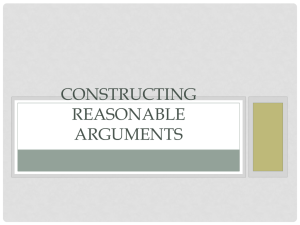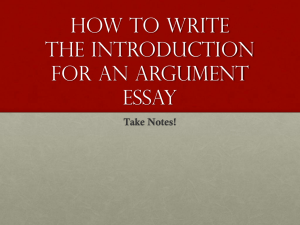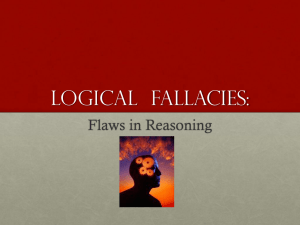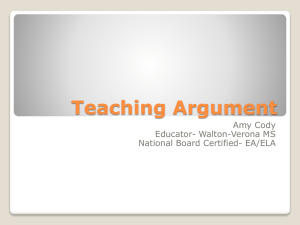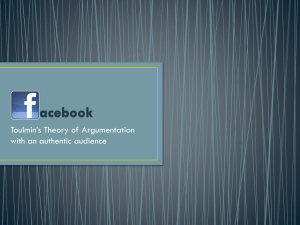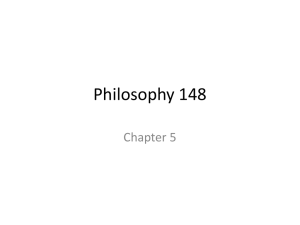Elements of Argumentation
advertisement
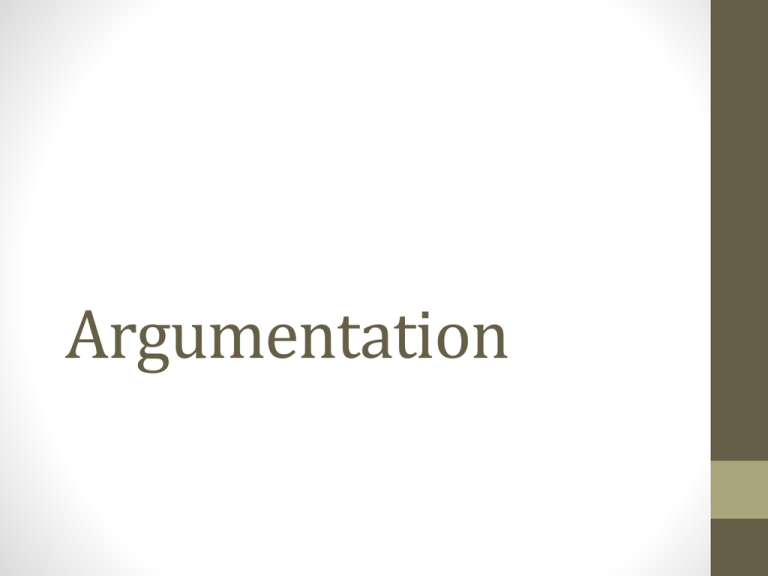
Argumentation Essential Questions • What is justice? • What issues resonate across cultures? • How are arguments are developed? Unpacking EA 2B Prompt: Develop an argument about an issue that resonates across cultures. Choose a position, a target audience, and effective structure to convey your argument. DO NOW: Deconstruct the above prompt. What skills and knowledge do you need to have to complete this prompt? Develop an argument about an issue that resonates across cultures. Choose a position, a target audience, and effective structure to convey your argument. Skills Knowledge Rhetorical Appeals (Persuasive Language) • Pathos – emotional appeal Describes the writer’s appeal to an audience's emotions. • Logos – logical appeal Describes the writer’s appeal to the reader’s logic/reason by making a reasonable claim and offering proof in support of that claim, whether the reader agrees or not. • Ethos – ethical appeal Describes the writer’s appeal that relies on the credibility of the author. The reader asks themselves, "What does this person know about this topic?" and "Why should I trust this person?" "50% of marriages end in divorce" "My mother was diagnosed with multiple sclerosis when I was twelve. I saw her pain and suffering which is why I want to support MS research." "Before I was president, I was the governor of New York." "As your doctor, I have to tell you that if you don't stop smoking, you're going to die." Analyze Rhetorical Appeals • “On Surrender at Bear Paw Mountain, 1877” (150) • “On Women’s Right to Vote” (151-152) Elements of Argument • Claim – the thesis of the argument • Evidence - support for the claim/thesis Commentary- explanation of why and how the evidence supports the claim • Counterclaims – a position taken by someone with an opposing viewpoints or evidence that disagrees with your thesis Concession – admission that the opposing side has valid points • Refutations – Evidence or reasoning that negates the counterclaims • Conclusion – concluding statement that pulls the claim and evidence together to create a call to action Forms of Evidence • Evidence - used to support a thesis/claim in an argument • Empirical evidence – based on experience and direct observation through research • Logical evidence – based on facts and a clear rationale • Anecdotal evidence – based on personal accounts Identifying Elements of an Argument Read “Time to Assert American Values” (142) • Identify the claim. • Identify the evidence. • What types of evidence are used? • Identify the concessions. • Identify the refutation. • Identify the call to action. • How did the write signal the conclusion? Reasoning & Evidence To evaluate an argument: • Determine whether a writer’s reasoning is valid • Determine if the evidence provided sufficiently supports the claim • Be aware of the use of common fallacies Analyzing an Argument Read from Mohandas Ghandi’s “On Civil Disobedience” (148) • Identify intended audience. • Identify claim. • Identify supporting evidence. • Identify the organization of the argument. Common Fallacies • Hasty Generalizations – a conclusion based on insufficient or biased evidence; rushing to a conclusion • Either/Or – a conclusion that oversimplifies the argument by reducing it to only two choices • Ad Populum – an emotional appeal that speaks to positive or negative feelings rather than the real issue • Moral Equivalence – a comparison of minor misdeeds with major atrocities • Red Herring – a diversionary tactic that avoids the key issues, often by avoiding opposing arguments Evaluating Reasoning • Look back at from “On Civil Disobedience” • Identify examples of fallacious reasoning (common fallacies) Unpacking EA 2B Prompt: Develop an argument about an issue that resonates across cultures. Choose a position, a target audience, and effective structure to convey your argument. DO NOW: Deconstruct the above prompt. What skills and knowledge do you need to have to complete this prompt?


